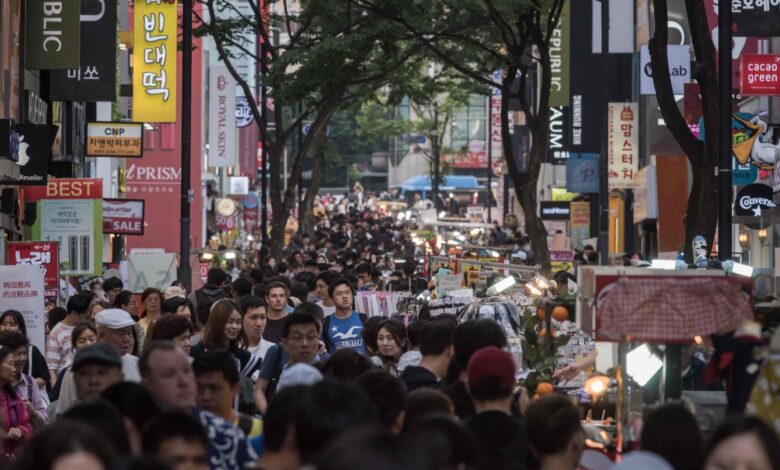Why is the government of South Korea worried about its declining population?

It was for the very first time that South Korea witnessed a higher number of deaths over the past year in comparison to the number of births in the country. This has obviously, led to a steep decline in the country’s population. In 2020, 2.75 lakh babies were born in South Korea while as many as 3.07 lakh people died. According to the reports by BBC, the number of new births dropped down by 10 per cent from 2019 leading the country’s population to settle at 5,18,29,023 at the end of 2020. This marked a marginal drop of 20,838 people from the year before.
But What is making South Korea’s population decline?
South Korea is a highly industrialised nation with a birth rate at 0.92, which is among the lowest in the world as of 2019. The number 0.92 here refers to the number representing the average number of children that are birthed by a woman.
For the replacement of the existing population, a fertility rate of 2.1 is required and as visible South Korea’s figure is substantially lower than the required.
The fertility rate of India in 2019 was 2.2, which is tentatively more than the desired rate.
According to a report by the Guardian, South Korea’s population growth rate slipped down to 0.05% by 2019 from 1.49% in 2010, giving immense stress to the government. And if this trend stays on the same path, the government predicts a magnum drop in the population of the country. Estimates show that the population could drop from the current 5.18 crore to 3.9 crores by 2067. Furthermore, the population in 2067 will have as much as 46 per cent of the people to be aged above 64 years.
Why does South Korea have a low population?
It is a common notion that greater economic development and lower fertility rates go hand in hand, as is seen in many parts of the world. Some of the reasons in South Korea, one of the most industrialized nations in the world, are listed below.
- Reluctance to opt for maternity leave
- High real estate prices which dissuade young couples from buying a house
- The high cost of living which gives second thoughts to people in starting a family.
How is the government planning to address this population problem?
According to the sources, the government of South Korea is planning to bring in a few “fundamental changes” to cater to this devastating trend.
President of South Korea Moon Jae, in December, announced corrective policies, like giving cash incentives for families, in order to influence people. This cash incentive scheme is to be started in 2022 and will provide a one-off payment to help cover parental costs. This one-off payment shall be tantamount to 2 million won or around Rs 1.35 lakh for each child that is born along with an additional 300,000 won or Rs 20,000 every month until the baby turns one.
The plan is also to raise this incentive to 500,000 won or Rs 34,000 after the year 2025.
What are the pros and cons of having a dwindling population? Is it always undesirable?
A drop in the young population of a country creates labour shortages that have multiple detrimental impacts on the economy.
If the population of a country is dominated by older people, it means that demands for healthcare and pensions can rise higher than ever. This could in turn, burden the social spending system of the country, especially when fewer and fewer people are contributing to it.
On the other side of the table, declining birth rates can actually help the government to improve the standard of living in countries with low-income, since, fewer children being born there would lead them to enjoy greater access to the limited resources.
Further, it is also being expected by the scientists that more number of aged people would perhaps add an increasing burden on healthcare making their costs to shoot up around the world. This would happen because people across the globe are increasingly focusing on “healthy life expectancy” and not just life expectancy.
Another dramatic effect of a fall in population shall be seen in the trends of migration. The declining population provides an impetus to migration as the countries would have to open up borders and allow more immigrants to come in and work due to the falling numbers of young people leading to labour shortages in the country. Thus, this could possible cause their society to become more cosmopolitan in the coming days.
Do we expect the world’s population to fall in the coming years?
A lancet analysis which was conducted in July 2020 said that the world population will face its peak in 2064 with as many as 973 crore people. And from there on, it will decline to reach approximately 879 crores in the year 2100.
India’s population is expected to peak at 160 crores in 2048 as against 138 crores in 2017. After reaching the peak of 2048, the population numbers are expected to fall by 32 per cent to 109 crores in 2100.
The global total fertility rate (TFR) is also predicted to face a steady decline to 1.66 in 2100 from 2.37 in 2017. The Total Fertility Ratio is expected to drop below 2.1 in 183 countries and shrink by more than 50% in 23 countries including Thailand, Japan, Italy and Spain.




